The average cost of termite remediation can be anywhere from $3,000-$8,000 depending on the extent of the damage. Such remediation costs can be so burdensome due to termites’ ability to attack the structure of a home including ruining subfloors, collapsing floors and ceilings, and even wrecking the integrity of a roof. Devastating damage can be caused in as little as three years with very few warning signs. Needless to say, many homeowners inquire about the best ways to prevent termite damage and protect their homes. Is there a way to prevent thousands of dollars in damage and keep termites out?
.png?width=250&height=210&name=Termite%20(1).png)
What is a termite?
Termites are an incredibly old (think Late Jurassic period) detritophagous eusocial insect that feast on a variety of decaying plant matter such as wood, leaf litter, and soil humus. Sometimes referred to as “white ants”, termites are soft-bodied and pale in color, appearing very similar to large white ants although only distantly related. They can be found throughout most of the world and are especially prevalent in tropical regions. Unsurprisingly, they are extremely rampant in the United States and can be found in 49 out of the 50 with only Alaska remaining termite-free.
The most common termite species found in the U.S. is the native subterranean termite, while other less common species include the drywood termite, dampwood termite, conehead termite, and highly invasive Formosan termite. When most homeowners think of termites, they are likely picturing the subterranean termite. These termites are incredibly common in homes and are often the cause of more extensive (and expensive) home damage. The second-most common household termite is the drywood termite, which thrives on consuming hard, dry wood like structural beams and timbers.
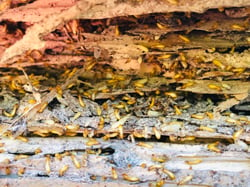 Subterranean termites working
Subterranean termites working
Termite Lifecycle and Biology
Termite damage can occur quickly and with little warning – this is due, in part, to the termite’s ability to rapidly reproduce and grow their colony. A termite’s lifecycle can be broken down into three stages: egg, nymph, and adult. Termite queens can lay up to 30,000 eggs per day and these eggs are fiercely protected by the entire termite colony. When the eggs hatch, immature termites called nymphs will emerge.
Nymphs are nearly translucent in color and look remarkably similar to maggots in this stage. Through the molting process, a nymph will begin to develop an exoskeleton, shed it, and repeat the process up to three times. Nymphs will also grow larger and darker throughout molting until reaching maturity. During the nymph stages, the termites do not eat wood. Instead, the workers of the colony feed them into adulthood.
When the nymphs fully mature, the termites will fall into colony hierarchy and roles. Most of the termites will go on to become worker termites, responsible for the potential destruction of your home. Other termites will be soldiers and some become reproductive termites, known as alates. Interestingly, you can actually discern the termite’s role within the colony by their appearance. Worker termites are wingless and creamy white in color. Soldier termites are also creamy white in color but have an enlarged head that is darker than the rest of their body and has a large pair of mandibles.
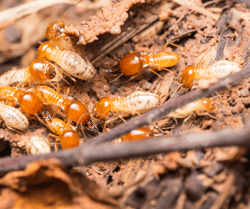 Soldier termites
Soldier termites
What damage can termites cause?
Depending on the species of termite and the size of the colony, termite damage can be considerable. Because termites feed primarily on wood, termites have the capability of compromising the structural integrity of your home. This means they can jeopardize your home’s integrity, weakening the architectural stability and even rendering structures uninhabitable. A home’s framing can be obliterated by a large colony and walls, ceilings, floors, and subfloors can collapse from catastrophic termite damage. The damage termites can cause should not be underestimated.
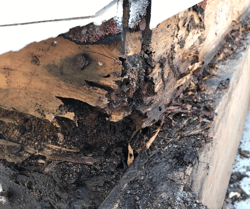 Termite damage
Termite damage
What are the signs of termite damage?
Unfortunately, some termite damage does not become apparent until a full-blown infestation occurs. This is especially true for internal damage, as termites typically work from the outside inward. Internal damage nearly always points to an infestation left unchecked and it’s highly probable that there is considerable exterior damage, as well. Luckily, there are some signs of termite damage to look out for to prevent further damage.
- Buckling wood
- Swollen floors or subfloors
- Bulging ceilings
- Damage on walls and ceilings that looks like water damage
- Discolored or drooping drywall
- Visible mazes within walls or furniture
- Peeling paint
- Mud tubes located near the foundation of the home
- Cracked wood furniture or other wooden items
- Small holes in drywall
- A mildew or mold-like scent
- Sudden or overt squeaking in floorboards
- Wing piles left after swarms
If you spot signs of a potential termite infestation in your home, contact a trusted pest professional immediately. Catching an infestation early and before too much damage has been caused is the best way to protect the integrity of your home and avoid shelling out several thousand dollars in repair costs.
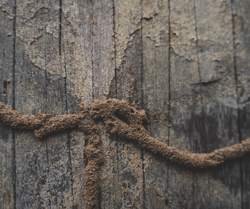 Termite mud tubes
Termite mud tubes
How can I prevent termites from damaging my home?
The only way to prevent termite damage is to prevent termites from attacking your home altogether. While certainly easier said than done, there are a few ways that you can help make your home a less easily accessed or hospitable place for termites to hang out. Some prevention tactics include:
- Remove any unnecessary lumber, mulch, wood, or other cellulose-based debris from near the foundation of your home.
- Stack firewood away from the home and ensure the wood is raised off the ground.
- Be mindful of landscaping around the foundation of your home. Wood mulch against your home’s foundation may draw termites near.
- Consider using pine needles or pea gravel in your landscaping.
- Regularly cut and rake any grass near your home.
- Reduce moisture around your home’s foundation by ensuring water from gutters or other drainage is directed away from the home.
- Ensure sprinkler heads are pointed away from the home.
- Utilize vapor blocks to reduce moisture and use dehumidifiers where needed.
- Keep dead trees, rooting wood, and tree stumps away from the home.
- Seal cracks around your home foundation and utilities that may lead to water entry or buildup.
- Turn off outdoor lights at night as they can attract flying termites and swarms.
- Check your roof for signs of water damage, mold, or rot. This is especially important for homes with flat areas of their roof where standing water can accrue.
- Get regular termite inspections from a trusted pest professional.
- Sign up for termite monitoring services from a trusted pest professional.
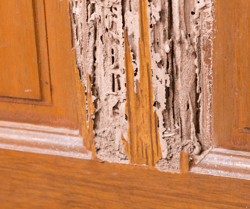 Termite damage to door
Termite damage to door
What should I do if I suspect I have termites?
If you suspect you have termites in your home, we recommend you call a trusted pest professional like EcoShield immediately. Time is of the essence when dealing with termites and delays in receiving treatment can result in more damage caused and more money required. With the Shield Termite Program, EcoShield offers year-round protection against termites and catches any potential termite activity before it becomes a headache.
A thorough inspection of your home will allow EcoShield pest technicians to identify problem areas and target them for treatment. EcoShield’s proven termite removal strategy ensures the entire colony is treated through the use of dependable products and with the informed knowledge of a termite’s habits, life cycle, and biology. Termite monitors will be installed every 15 feet to detect termite activity before it becomes catastrophic to your home and wallet.
If you’re experiencing a problem with termites in your home or would like to prevent termite damage in the future, call EcoShield today for a free no-obligation quote.